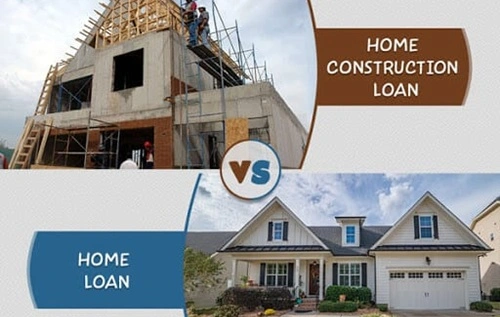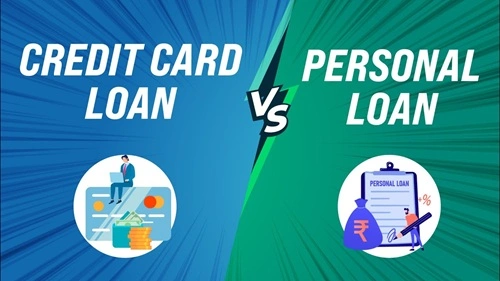Buying or building your dream home is one of the biggest financial decisions of your life. Whether you’re planning to purchase a ready-to-move-in house or build one from scratch on your own plot, banks and housing finance companies in India offer different types of loans tailored to meet these needs—Home Loans and Construction Loans.
Although both help you finance your house, there are significant differences in terms of loan structure, disbursement process, eligibility, documentation, and usage. Understanding these differences will help you choose the right loan based on your specific requirements.
Let’s explore the meaning, features, and key differences between a home loan and a construction loan in India.
What is a Home Loan?

A home loan is a type of secured loan provided by banks or housing finance companies to help you buy a ready-to-move-in house, apartment, or an under-construction property from a builder or seller.
✅ Key Features of Home Loans:
- Offered for buying ready-to-occupy or under-construction homes.
- Loan amount is usually up to 75–90% of the property value.
- Tenure can go up to 30 years.
- Interest rates range from 8% to 10.5% p.a. (depending on lender and applicant’s profile).
- EMIs start immediately after the full disbursal.
✅ Usage:
- Purchase of flat/apartment
- Buy a resale house
- Buy an under-construction builder property
What is a Construction Loan?
A construction loan is a type of loan provided for the purpose of constructing a house on a plot owned by the borrower. It’s different from a home loan because the property is not yet constructed, and the loan is disbursed in stages, based on the progress of construction.
✅ Key Features of Construction Loans:
- Offered only if the borrower owns a plot of land.
- The plot should be legally approved and free from disputes.
- The loan is disbursed in phases, depending on the construction stage (foundation, slab, roof, finishing, etc.).
- Tenure usually ranges from 5 to 30 years.
- Interest rates are slightly higher than standard home loans (around 8.5% to 11% p.a.).
✅ Usage:
- To build a house on a self-owned residential plot.
- Some lenders also allow plot + construction loan under one scheme.
Key Differences: Home Loan vs Construction Loan
| Parameter | Home Loan | Construction Loan |
| Purpose | Buying a ready or under-construction home | Building a house on a self-owned plot |
| Ownership of Land | Not required | Must own the land |
| Disbursement Mode | Lump sum (or in stages for builder homes) | In stages as per construction progress |
| Interest Rate | 8% – 10.5% p.a. | 8.5% – 11% p.a. |
| Loan Amount | Up to 90% of property cost | Depends on construction cost and land value |
| EMI Start Time | After full disbursal | Starts as each disbursal happens |
| Documents Required | Sale deed, builder agreement, NOC | Approved building plan, land papers, estimate |
| Processing Time | Comparatively faster | May take longer due to technical verifications |
| Tax Benefits | Eligible under 80C and 24(b) | Same tax benefits apply after completion |
Disbursement Process: How It Works
🔹 Home Loan Disbursement:
- If the property is ready, the bank disburses the full amount directly to the seller.
- For under-construction properties, banks release payments in stages based on the builder’s demand and project progress.
🔹 Construction Loan Disbursement:
- Funds are not released in one go.
- Banks release money in stages such as:
- Foundation work
- Slab laying
- Brickwork
- Roofing
- Finishing work
- Each stage is inspected by a bank-approved engineer before releasing the next installment.
Pros and Cons
✅ Home Loan – Pros:
- Simpler approval and disbursal process.
- Lower interest rates and long tenure.
- Less documentation if buying from a reputed builder.
- Immediate possession if property is ready-to-move.
❌ Home Loan – Cons:
- Limited customization of design/layout.
- Risk of project delay if buying under construction.
- Higher cost if builder inflates price.
✅ Construction Loan – Pros:
- Full control over design and material quality.
- Can be cost-effective if planned well.
- Suits individuals with an inherited or bought plot.
❌ Construction Loan – Cons:
- More complex paperwork.
- Disbursal is stage-wise and involves technical inspection.
- Higher interest rates and stricter scrutiny.
- Delays in construction may affect repayment planning.
Loan Eligibility Criteria: (Common for Both)
Most banks and NBFCs consider the following factors for home or construction loan approval:
- Applicant’s age: 21 to 60 years
- Employment type: Salaried or self-employed
- Minimum income: ₹25,000 per month (may vary by city)
- Credit Score: 750+ preferred
- FOIR (Fixed Obligations to Income Ratio): Should be within acceptable limits
- Clean credit history with no defaults
Tax Benefits on Both Loans
Under the Income Tax Act, borrowers can avail the following benefits:
Under Section 80C:
- Up to ₹1.5 lakhs deduction on principal repayment (including stamp duty and registration charges)
Under Section 24(b):
- Up to ₹2 lakhs deduction on interest repayment (for self-occupied property)
- No limit if property is let out
Note: Tax benefits for construction loans start only after the construction is completed.
Which One is Right for You?
💡 Choose a Home Loan if:
- You want a ready or under-construction home from a builder.
- You don’t own a plot.
- You prefer a hassle-free process with faster disbursal.
💡 Choose a Construction Loan if:
- You already own a legal and approved plot.
- You want to custom-build your dream home.
- You are ready to manage and supervise the construction process.
Conclusion
Both home loans and construction loans serve the purpose of helping you acquire a home, but the choice depends entirely on your individual circumstances and goals. A home loan is ideal for those looking for a readymade solution, while a construction loan is perfect for those who value personalization and already own land.
Make sure to compare interest rates, understand disbursal rules, estimate total project costs, and evaluate your repayment capacity before applying.


